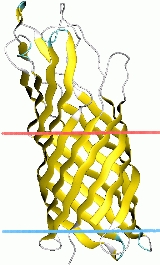
Outer membrane protein OpcA
Encyclopedia
Outer membrane adhesin OpcA protein family
consists of several Neisseria
species specific outer membrane proteins. Neisseria meningitidis
causes meningococcal meningitis
and septicemia. Opc (formerly called 5C) is one of the major outer membrane proteins and has been shown to play an important role in meningococcal adhesion and invasion of epithelial and endothelial cells, mediating attachment to host cells by binding proteoglycan
cell-surface receptors.
OpcA forms a 10-stranded beta-barrel with five highly mobile extracellular loops that protrude above the surface of the membrane. These extracellular loops combine to form a crevice in the external surface that is lined by positively charged residues, which is predicted to be a binding site for proteoglycan polysaccharides involved in pathogenesis. Conformational changes in the extracellular loops modulate the surface of OpcA, which could affect the proteoglycan binding site. These conformational changes could also lead to pore opening.
Protein family
A protein family is a group of evolutionarily-related proteins, and is often nearly synonymous with gene family. The term protein family should not be confused with family as it is used in taxonomy....
consists of several Neisseria
Neisseria
The Neisseria is a large genus of commensal bacteria that colonize the mucosal surfaces of many animals. Of the 11 species that colonize humans, only two are pathogens. N. meningitidis and N. gonorrhoeae often cause asymptomatic infections, a commensal-like behavior...
species specific outer membrane proteins. Neisseria meningitidis
Neisseria meningitidis
Neisseria meningitidis, often referred to as meningococcus, is a bacterium that can cause meningitis and other forms of meningococcal disease such as meningococcemia, a life threatening sepsis. N. meningitidis is a major cause of morbidity and mortality during childhood in industrialized countries...
causes meningococcal meningitis
Meningitis
Meningitis is inflammation of the protective membranes covering the brain and spinal cord, known collectively as the meninges. The inflammation may be caused by infection with viruses, bacteria, or other microorganisms, and less commonly by certain drugs...
and septicemia. Opc (formerly called 5C) is one of the major outer membrane proteins and has been shown to play an important role in meningococcal adhesion and invasion of epithelial and endothelial cells, mediating attachment to host cells by binding proteoglycan
Proteoglycan
Proteoglycans are proteins that are heavily glycosylated. The basic proteoglycan unit consists of a "core protein" with one or more covalently attached glycosaminoglycan chain. The point of attachment is a Ser residue to which the glycosaminoglycan is joined through a tetrasaccharide bridge...
cell-surface receptors.
OpcA forms a 10-stranded beta-barrel with five highly mobile extracellular loops that protrude above the surface of the membrane. These extracellular loops combine to form a crevice in the external surface that is lined by positively charged residues, which is predicted to be a binding site for proteoglycan polysaccharides involved in pathogenesis. Conformational changes in the extracellular loops modulate the surface of OpcA, which could affect the proteoglycan binding site. These conformational changes could also lead to pore opening.

